Oct 28, 2013 | advice, coins, gold, investment, markets, silver
I always welcome email from readers and the curious but I received an email with an interesting question. My correspondent had become interested coin collecting as an investment and wanted to know if I knew where to find out how much the gold coins would be worth in 10 or 20 years. Channeling my inner Edward Moore (from his play The Gamester) or Dr. McCoy for the Star Trek fans, I replied “If anyone knew the answer to that question they would rich beyond the dreams of avarice!”
This is not the first time someone asked me what I thought would be the price of rare or gold coins in the future. It is also a question that I do not like to answer since I am a collector and not an investor.
Markets are difficult to predict. Even the experts get it wrong. For example, a simple Internet search will find articles that appeared in MarketWatch, Reuters, and The Guardian from the United Kingdom predicting $2000 per ounce prices for gold. In March, the financial site The Motley Fool had an article saying that gold could hit $2000 per ounce next year.
In reality, gold opened the year at 1670.95, the high for 2013 and is 1309.64 as of Friday’s (October 25) close. Even with a small spike in August, the trend is going down. But does the trend mean that gold will still go down?
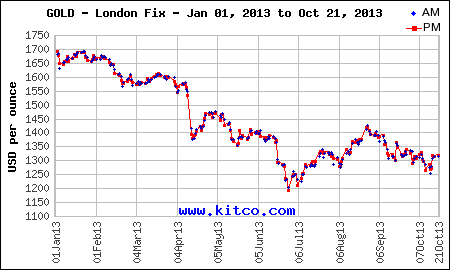
Kitco gold chart for 2013 through October 21, 2013
Trying to read the financial tea leaves has long been a sport for the financial pundits. One pundit writing for Forbes noted that the dollar strengthened while gold and crude oil dropped while last week, another pundit from Bloomberg wrote that stocks and gold rose as the dollar falls on the reaction earnings that have been topping estimates and the prediction of slower economic growth predicted by the Federal Reserve saying it will maintain its stimulus program. In between, an analyst at Yahoo Finance was predicting “a major turnaround in the US Dollar versus the Euro, but gold prices may actually outperform versus the Greenback.”
Predicting the price of gold and rare coins can be a similar test of ones nerves. One interesting way to look at the market is to see what the PCGS3000 Index says. The PCGS3000 index uses a sampling of collector coins, type coins, varieties, and differing grades to create a market index. Their sample are considered classic coins (1792-1964) including gold and early commemoratives to total 3000 coins.
This recent history of collector coins shows an upward trend over the last year as the economy has improved (see graph below on the left). However, looking over the last 10 years (graph below on the right) the peak occurred before the economy turned sour at the end of 2008 and has largely remained flat since falling to a low in 2010.
-
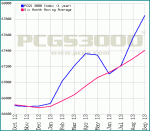
-
PCGS3000 one year graph showing an upward trend
-
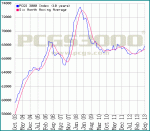
-
PCGS3000 ten year chart showing the unpredictability of the coin market
Does this mean gold and rare coins are not a good investment? If you bough during the run up in value in 2008, you are behind. However, coins purchased from the beginning of the ten-year chart should yield a better return for investors.
Those thinking that gold coins may be a better investment might want to consider that the price of their coins will be tied to the price of gold. Both the PCGS Generic Gold Coin Index (below on the left) and the PCGS Mint State Rare Gold Coin Index (below on the right) almost mirrors the gold market over the last year. In fact, looking at the 10 year history the Mint State Rare Gold Coin Index almost mirrors the PCGS3000 Index while the Generic Gold Coin Index is all over the place and does not even follow the price of gold for the last 10 years.
-

-
PCGS Generic Coin Index for the past year
-
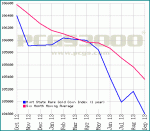
-
PCGS Mint State Rare Gold coins showing a downward trend
-

-
PCGS Generic Gold Index for the last 10 years shows almost no trend
-

-
PCGS Mint State Rare Gold Index seems to mirror the PCGS3000 index.
While you are thinking that this may be particular to gold coins, investors in 20th Century Coins (see chart below on the left) and Morgan and Peace Dollars (below, right) may be scratching their heads looking for a better return.
-
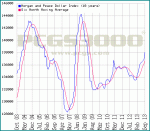
-
PCGS Morgan and Peace Dollar Index for the last 10 years
-
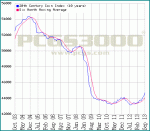
-
PCGS 20th Century Coin Index may indicate that coins from our recent past may not be a good investment.
As a layman, what appears to be a hot market is the very high end market. These are the extremely rare coins, coins with extraordinary pedigrees, and unique collectibles. Not every collector or investor is going to be able to own a 1794 Flowing Hair dollar that sold for $10 million last January, the George Walton 1913 Liberty Head Nickel, or a 1880 Coiled Hair Stella which is really a pattern that sold for $2.5 million in September. Even rare copper coins are selling at a premium.

1857 Seated Liberty half dime
Predicting the coin market is more difficult than stocks and commodities. With the capital markets there is company performance data, yield of crops, world conditions, and a lot of measurable factors that the professionals use. None of that exists in the coin investing market. Prices can be predicted by rarity to a certain degree, much of the pricing appears to be based on emotion: what will you pay for the coin. For instance, if the 1794 Flowing Hair dollar sold for $10 million what would the only legal-to-own 1933 Saint Gaudens Double Eagle sell for today? It used to hold the record for the most ever paid for a single coin when it sold at auction for $7,590,020 (including buyers premium and the $20 that was required to monetize the coin) in 2002.
In case you were interested, according to the Bureau of Labor Statistics CPI Inflation Calculator, adjusted for inflation, the price paid for the 1933 Double Eagle in 2002 is $9,867,321.33 in 2013 dollars. Even adjusted for inflation, the price does not beat the 1794 dollar!
If you are interested in trying to test this market, I wish you well. I am a coin collector not an investor. I do not think that will change. However, if you are looking for an interesting investment market, I hear the market for classic cars, including the muscle cars of the 1960s and 1970s are an affordable and growing market. And if you do not want to enter that market for investment, at least you can consider an emotional purchase—like I did!

This 1974 Plymouth Gold Duster with a 225 Slant 6 is a memory that is on a truck on its way to is new home in my garage!
Gold charts are courtesy of
KitcoThe coin market charts are all from
PCGS and their
PCGS3000® index.
Half Dime image from Wikipedia.
Sep 5, 2012 | advice, gold, investment, news
Gold Buyers Beware: Experts Caution Coated Tribute Coins Are Not “Gold Coins”
 PNG Press Release: Temecula, California—With the price of gold recently increasing, people who want to invest in the precious metal should be cautious about the potential investment value of gold-plated “tribute coins,” according to the Professional Numismatists Guild (www.PNGdealers.com), a nonprofit organization composed of many of the country’s top rare coin and currency dealers.
PNG Press Release: Temecula, California—With the price of gold recently increasing, people who want to invest in the precious metal should be cautious about the potential investment value of gold-plated “tribute coins,” according to the Professional Numismatists Guild (www.PNGdealers.com), a nonprofit organization composed of many of the country’s top rare coin and currency dealers.
Frequently advertised on television, the tribute items are replicas of popular United States Mint gold bullion coins, but are privately produced and often contain only a tiny amount of gold.
“These tribute replicas may be fine souvenirs and mementos as inexpensive medallions, but should not be considered an actual precious metal investment because they have only a razor-thin coating of gold and virtually no secondary market value as gold. They’re also not a United States Mint product, so they’re not even U.S. legal tender coins even though their designs may be similar to actual U.S. coins,” cautioned Jeffrey Bernberg, PNG President.
“Some of the look-alike tribute ‘coins’ are advertised as containing 14 milligrams (mgs) of 24 karat gold. That equals a minuscule .00045 troy ounce of gold; less than one-thousandth of an ounce. So, if the price of gold is at $1,690 an ounce, then 14 milligrams would be equal to only about 76 cents worth of gold,” he explained.
The Professional Numismatists Guild was founded in 1955. PNG members must adhere to a Code of Ethics that prohibits use of high pressure sales tactics and misrepresentation of the value of items being sold. PNG members also must demonstrate knowledge, responsibility and integrity in their business dealings, and must agree to binding arbitration to settle unresolved disagreements over numismatic property. A complete list of PNG member-dealers can be found online at www.PNGdealers.com.
For a copy of the informative pamphlet, “What You Should Know Before You Buy Rare Coins,” or a printed directory of PNG member-dealers, send $1 to cover postage costs to: Robert Brueggeman, PNG Executive Director, 28441 Rancho California Rd., Suite 106, Temecula, CA 92590. Phone: (951) 587-8300. Email at info@PNGdealers.com, or visit the web site at www.PNGdealers.com.
Apr 10, 2011 | gold, investment, silver
On January 28, 2011, the spot price for silver closed at $26.68 per troy ounce. That was almost $4 lower than it opened on January 4, the first trading day of the year. Since then, silver has climbed steadily to close at $40.22 on April 8. A rise that has seen the price of silver gain a bit more than 50-percent in value.
Some are wondering if the price of silver could hit the $48.70 it did in 1980 when the Hunt Brothers, Nelson and Herbert, tried to corner the silver market. Although the comparisons are interesting, it would only be a numeric record. Accounting for inflation, the actual value would be $130.80 in terms of 2011 dollar. For a true record, silver has a long way to go!
Since the economic downturn, there have been significant investment in gold pushing prices higher with it reaching a record of $1,469.50 per troy ounce as of Friday’s close. However, silver has remained relatively flat until this year. The one explanation that makes sense is that silver remains a good investment because it is undervalued as compared to gold—called the spread or ratio of silver to gold.
Historically, prior to the deregulation of markets, governments have fixed the spread around 15-to-1, meaning that the price would be set to where 15 ounces of silver would buy one ounce of gold. This changed during following deregulation of the markets. One analyst found that gold was over 100 times more expensive than silver but the price ratio never went below 41.51.
At the beginning of the year, a few analysts commented that silver was prime to rise because of the gold-to-silver ratio was very wide. Some suggested that the ratio should be closer to 25-to-1 even though it has never been lower than 41-to-1. However, as of Friday’s close, the ratio is now 36.29!
Some analysts believe that as the dollar falls in value, the prices of both gold and silver will rise. Projections see gold rising to anywhere from $1,500 to $1,600 per ounce. But because this price is high for some investors, silver looks like a better value and is expected to hit the $50 mark before the end of the year. Given its trend and the nature of the markets, it could reach $50 by the summer.
If you are not an investor but a collector of United States coins from prior to 1965, the value of your collection has been going up. Do you have American Gold Eagles? You might have noticed that some of your coins have more than doubled their original price, even for the one-tenth ounce. Remember when the first Gold Buffalo sold for $650? Now add a $200 premium to the gold spot price to find the current value.
Are you collecting dimes? Just the silver value of the dime is $2.96. Those Kennedy Half-Dollars that your father or grandfather saved from 1964 have $14.80 worth of silver. And those common date Peace Dollars (1922-23) that sold for $20-25 a year ago is now worth $31.65 in silver.
By the way, those 1965-1970 Kennedy Halves that are 40-percent silver contains $6.05 worth of silver.
The analysts who determine and publish the values of coins have been very busy!
I am not suggesting that anyone buy gold or silver as an investment—speak to your investment advisor before doing anything. I am looking at the situation from a collector’s point of view. The rise of prices makes my collection worth more when considering the bullion value and the numismatic premium. Maybe now is a good time to consider selling some of my collection—the parts I am less emotionally attached to—and start over again when metals prices drop. In any case, we certainly live in interesting times!
Jan 2, 2011 | coins, economy, gold, investment, policy, silver
Many things can be said about 2010, but for numismatics and precious metals it was quite a ride. What could this ride tell us about 2011?
Looking at the economy, the real gross domestic product—the output of goods and services produced by labor and property located in the United States—increased at an annual rate of 2.6 percent in the third quarter of 2010. A rate greater than in 2009. Although real disposable personal income increased 0.2 percent through November, the consumer price index rose at a faster rate of 1.1-percent while unemployment reached a one-year high of 9.8 percent in November.
If the slow improving economy and expanding unemployment has you confused, the simple explanation is that if the economy was a bus, it just pulled away from the curb and the driver started to shift into second gear while employment has yet to be allowed aboard. Although economists agree that employment and Consumer Confidence Index are lagging indicators, neither have seen improvement in 2010. Although the politicians are hoping their lame duck legislative efforts will help the unemployed to board the employment bus, it is possible that the bus will be too far down the road to make a difference in 2011. Let’s hope it is not too late!
In an attempt to provide its version of stimulus in 2010, the Federal Reserve’s lowered its discount rates and its ability to manipulate the money supply to try to provide relief. Although the Fed has increased the money supply, the United States dollar has not been significantly weakened against most of the world currencies—although some would say that it was seriously weakened in 2009. While the dollar has fluctuated against other major currencies throughout the year, the dollar has shown marginal only weakness against the British Pound, Euro, and Yen year-over-year while there were no weaknesses against the Reniminbi (or Yuan) because of institutionalized currency manipulation in China. Many economists believe that the avoidance of a dollar free-fall was because of the failure and pending failure of some Eurozone economies and China’s desire to reduce its own inflation concerns. The rumblings to remove the dollar as the standard and benchmark currency that we heard in 2009 subsided in 2010.
To measure the effect of the economy on the numismatic markets, I use the PCGS3000® Index as an indicator. The PCGS3000 Index is a market basket of 3,000 coins that PCGS their analysts believe represents the broad market. The variety of coins makes for a good indicator but as a broad market basket, movement indicates trends rather than a real-time indicator (similar to the Russell 2000).

The PCGS3000 Index opened 2010 with at 68,476.87. After dropping to a 12-month low of 66,886.27 (↓2.3-percent) in August, the index closed at 67,323.11, down ↓1.68-percent for the year. For a market basket that consists of 3,000 non-volatile items made from a variety of metals an in different grades, a downward trend of one-to-two percentage points indicates a weakness in the numismatic market. While some think the markets are strong—and there has been no slow down in the high-end coin market—collectors and some investors are either pushing prices downward or waiting for prices to drop before buying. Like in retail sales, many purchasers are standing on the sidelines waiting for the bargains or the market to settle.
But if the economic indicators do not show weaknesses except in employment, then why should the numismatic market show a weakness? The answer can be summed up in two words: gold and silver.

Some dealers and auction houses have found that the buyers for the high-end coins have continued their strong buying but the rest of the market has not joined them. One of the factors can be that the price of gold has scared many people away. When the markets opened on January 4, 2010, the price was $1,087.50 for one troy ounce of gold. During the year, the price never dipped below $1,050 climbing to $1,420 on December 7 before closing at $1,405.50 on December 30. As a result, investors who bought gold prior to 2010 saw their investment to rise 29.2 during the year. One would think it makes sense that the generic gold coin market would rise with the gold market. But a look at the PCGS Generic Gold Coin Index found that even with gold’s rise through the year, the generic gold coin market also saw a 17.76-percent drop in prices. However, Proof Gold rose only four-tenths of one-percent (0.41%) showing that there continued to be a little activity in the high-end market.

If there was a bull market in 2010 they were running for silver. After opening the year at $16.99 per troy ounce, silver closed at $30.63—a whopping 80.4-percent increase! Although less than the $54 ($143 adjusted for inflation in 2010 dollars) that it reached when the Hunt Brothers tried to corner the silver market in 1980, the 2010 rise is significant because few believe that the markets are being manipulated. In fact, one analyst believes that the silver market is undervalued as compared to the gold market. He said, “The gold rush of the 2000s is going to be nothing [compared] to the silver rush of the 2010s.”
When looking at the numismatics market, silver is the key metal. Up until 1964, every dime, quarter, half-dollar, and non-gold dollars were made of silver. Silver has been a key coining metal since the creation of the United States Mint in 1792. Many of the most collectible coin ever created by the U.S. Mint were struck in silver. Nothing represents silver coins like Morgan and Peace Dollars. Arguably one of the most popular numismatic collectibles, Morgan and Peace dollars are 26.73 grams made of 90-percent silver and 10-percent copper making its melt value $23.03 at the end of 2010.
But the value of Morgan and Peace dollars extend beyond their melt value. Morgan and Peace dollars are tied to the late 19th and early 20th century history of silver manipulation in the United States with designs popular with collectors. Morgan dollars struct at the Carson City mint are amongst the most desired. Since the GSA sales in the 1970s, the prices of these coins have gone up—in some cases beyond the reach of the average collector. Of the Peace dollar series, the high-relief 1921-D dollar is very desirable as is the low mintage 1928 dollar, and the 1935 last year of issue dollars. And the rumor that not all of the 1964-D Peace dollars were melted makes finding out the absolute truth a great interest to the numismatic world. However, with the rest of the market trending downward and silver skyrocketing, the PCGS3000 Morgan and Peace Dollar Index found the market rise-then-fall-then-rise again to end the year up eight-tenths of one-percent (0.825-percent) for 2010. Not a great showing, but demonstrating that Morgan and Peace dollars are still popular amongst collectors.
What is clear is that the coin market was down in 2010 while investors and even some collectors might have been concentrating on gold and silver bullion.
In speaking with some dealers, many have said that they have survived the last two years buying and selling bullion including American Eagle coins. One said that the numismatic market has been very slow that the bullion market has allowed him to stay in business during this era being dubbed “The Great Recession.”
Just because the calendar turns does not mean the market will turn along with it. Even though the lame duck congress passed significant stimulus legislation, it will take some time for those measures to settle into the markets. Some experts think that the eventual hiring may not occur for at least six monist and that there will not be a significant drop in unemployment until the fall. Others point to the infrastructure project the new laws are supposed to support forgetting that even shovel-ready projects have legal requirements, such as contract and environmental restrictions, that have to be address before a shovel can be used. In short, we may be in for more of the same through the first and even second quarters of 2011.
The new congress will help keep the economic uncertainty alive. Although the Republicans will control the House of Representatives, the Senate will be controlled by the Democrats with an active Republican minority who has shown that they will use the body’s rules to try to force their will. In other words, prepare for gridlock. None of this takes into consideration that Rep. Ron Paul (R-TX) will be the chairman of the House Finance Committee, thus allowing him to have control over economic policy in the House!
Neither the lame duck stimulus or the new congress will do anything to settle the markets in the short term. With the uncertainty, investors will continue hedge their bets using precious metals. Gold will continue to rise but at a rate less than in 2010. It is fair to say that with the current valuation being so high, it is likely that 2011 will end with gold only rising by 20-percent. However, the argument that the gold-to-silver ratio is out of balance being very compelling, we may see silver continue to climb. Silver may not climb at the 80-percent rate we saw in 2010, but a 40-percent rate may be reasonable. If this holds true, this time next year we could be talking about gold being $1,680 per troy ounce and silver closing at $42.
During the Fall of 2010, the PCGS3000 Index rose a bit from its low for the year and the low since the index’s all-time high in 2008. But with other factors not changing in the short term, could this be the coin market’s version of a “dead cat bounce?” A dead cat bounce is a small yet brief market recovery derived from the idea that “even a dead cat will bounce if it falls from a great height.” It is more likely that the numismatic market will flatten a bit while the rest of the markets figure out which direction they will go.
The first indication of how the numismatic market starts the year will be at the F.U.N. Show held January 4-9 in Tampa, Florida. With F.U.N. being one of the largest non-ANA shows of the year, sales and dealer impressions will set the tone for at least the next few months. Under the premise that markets do not turnaround quickly and that the last major show, Whitman Baltimore Expo in November, saw only nominal sales, one can assume a similar atmosphere for F.U.N. It will be more reasonable to wait until the National Money Show March 17-19 in Sacramento and the Whitman Baltimore Expo held March 31-April 3 to determine if the numismatic market will be better in 2011. At the end of the year, it is reasonable to expect that the PCGS3000 Index will be up 2.5-percent by the end of 2011 given the other market forces.
Of course predicting any market is a total crap shoot. While my roll of the dice may be no better than others, I would caution against thinking that my crystal ball is clearer than anyone else’s. All I have done is read the proverbial tea leaves and drank the tea while throwing darts at the wall trying to guess what the future will bring. Or as one comedian used to say, “That’s my opinion, I could be wrong.”
Metals charts courtesy of Kitco.
The PCGS300® Index courtesy of the Professional Coin Grading Service.
Aug 30, 2010 | commentary, education, gold, investment
 At least once every month a reader will send an email note asking about the worth of coins they bought from a television shopping channel or from a company that advertises on cable television. Last week, someone asked specifically about coins bought from a company that sells gold on the show of a nationally known cable television personality.
At least once every month a reader will send an email note asking about the worth of coins they bought from a television shopping channel or from a company that advertises on cable television. Last week, someone asked specifically about coins bought from a company that sells gold on the show of a nationally known cable television personality.
I was surprised to learn what was being sold as investment quality coins. The person who I was corresponding with was sold Swiss and French gold coins whose values are a few percentage points over the melt value of the coin. My correspondent paid much more than the coins value. Unfortunately, the spot price of gold would have to climb over $1,500 per ounce for this person to break even on these coins.
Another email asked about the worth of State Quarter sets purchased from a television shopping channel. This person bought these sets as part of a subscription and paid three-to-five times the numismatic value for these coins. Even though the coins had nice presentation packaging, I was able to show the user online auctions where the coins are not selling for a premium that would allow him to break even.
Over a month ago, someone wrote to ask about a coin set sold by a large mail order coin dealer. As with other coins sold by this dealer, they were quality coins but were overpriced when compared to other dealers and price guides. Although the coins were in special packaging creating the illusion of a set, the price of the coins was 15-25 percent above the retail prices published in price guides.
The common denominator in these stories is that these people bought the sizzle and not the stake. They bought the special packaging or the promise of value trust the person on television, the other end of the telephone, or the pretty advertisement in a magazine. It breaks my heart to tell these people they overpaid!
Each of these people would not have made these mistakes if they had done a little research. Research is not that difficult. It starts with some basic questions: What is this coin really worth? Is this a good investment item? Who is this person I am buying from?
Over the last 10 years, there has been a surge in the publication of numismatic resources, whether it is in print or on the web. Books are being published by traditional hobby publishers and other general purpose publishers that can teach you about any coin type, how to invest in coins, and now there is a book that discusses how to sell the coin collection your grandfather left for you.
Other resources include online price guides, hobby magazines, and various websites that can help you in almost any topic in numismatics.
If that is not enough, ask questions. No question is too basic. When I taught college courses, I would remind my students that there is no such thing as a stupid questions—the only stupid question is the one not asked! Ask your favorite blogger. Ask your favorite dealer. Ask your question in a public forum that caters to coin people. Just ask!
The axiom that if the deal sounds too good to be true, it probably is not true. If you talk with someone about purchasing coins and they try to pressure you into buying immediately, do not give in to the pressure. It is your hard earned money and it is your prerogative to understand everything about how you spend that money.
Before I make any significant purchase, I will analyze the cost of the item before attempting the purchase. I select specific vendors to negotiate with and then contact them to open the conversation. When I negotiate I remember that I have the power. I may want the item, but it is my money the vendor wants. If the vendor wants my money then that person has to work with me. Otherwise, I am prepared to walk out.
If the vendor cannot answer my questions, I walk out unless they say they will find the answer. If the vendor will not answer my questions, I will walk out. If they negotiate in bad faith, I will walk out. If they treat me like they are doing me a favor, I stand up, shake their hands, thank them for their time, and then will I walk out.
Remember, you can say “no” as often as necessary. You can say “yes” only once. Make it count. Do not let the slick talking sales person sell you something that is not in your best interest. Know what you are buying and know how to just say NO!
Oct 20, 2008 | dollar, gold, investment, Morgan, Peace
There have been reports of the coin market continues to grow as the economy is falling. One measure is the PCGS3000 index that is based on a sample of 3,000 coins. Looking at the graph (see the right side of the page), the trend (blue) line continues upward. In fact, there is no downward place on the line. A trend graph would give an indication that the market is very hot and trending upward. But is that the case for the entire market?
 The PCGS3000 is supposed to be a representative sample of the coin market. But like the Dow Jones Industrial Average, it is not a complete view of the market since there are other segments that have reacted differently. One area that is more sensitive to the movement of the market is the Generic Gold Index (right). This index looks at what many consider common date gold and gold bullion coins where the coins are worth their metal value plus a nominal numismatic premium. The graph shows a volatility that can be traced to the market value of gold.
The PCGS3000 is supposed to be a representative sample of the coin market. But like the Dow Jones Industrial Average, it is not a complete view of the market since there are other segments that have reacted differently. One area that is more sensitive to the movement of the market is the Generic Gold Index (right). This index looks at what many consider common date gold and gold bullion coins where the coins are worth their metal value plus a nominal numismatic premium. The graph shows a volatility that can be traced to the market value of gold.
Gold is a volatile market. When I thought that rare and proof gold would be a better choice, I found that the Mint State Rare Gold and Proof Gold indices seem to be affected by the price of gold. While there may be individual coins that perform better than others, the market itself seems to belie the trend of the PCGS3000 index.
The idea from this article came when a friend asked me they should buy if they wanted to invest using coins. My friend heard that the US Mint was having problems producing gold coins and wanted to know what to do. Since I am a collector and not an investor, I had to do some research.
Researching market trends is not easy. Online price guides do not provide the historical data to make an analysis. Gold dealers are quick to tout the investment in gold and how great of an investment option it is. But I was suspicious. After all, if even rare coins are affected by the gold market, maybe gold is not the best of investments.
 I started to click on the links for the other graphs at the PCGS site and stumbled upon the Morgan and Peace Dollar Index (right). I have heard some dealers say that this market was moving, but I thought that was wishful thinking. But the graph shows that in the last year, the trend is upward. This was very interesting until I looked at the 10 year graph for Morgan and Peace Dollars.
I started to click on the links for the other graphs at the PCGS site and stumbled upon the Morgan and Peace Dollar Index (right). I have heard some dealers say that this market was moving, but I thought that was wishful thinking. But the graph shows that in the last year, the trend is upward. This was very interesting until I looked at the 10 year graph for Morgan and Peace Dollars.
My first impression was that the graph would overlay the trends in the economy with the exception of the downward trend during the technology bubble.
I was not sure what to tell my friend. I mentioned the Morgan and Peace Dollar market as a potential investment area. I also told the story of the GSA Morgan Dollars and their worth to collectors. I suggested high grade Morgan Dollars and later date, high grade Peace Dollars. I even discussed finding various die varieties that gets some collectors excited.
Although I was having fun clicking through vamworld.com, my friend was looking for something to invest in to either preserve a investment or to make money. I finally relented and suggested reading Profitable Coin Collecting by David Ganz. It seems to be the type of book that investors may find interesting.
While it is nice to see my collection is worth more than I purchased it, I am not collecting Morgan or Peace dollars because they are or will be worth more than when I purchased them.
Graphs courtesy of PCGS.


















